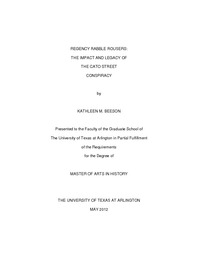
ATTENTION: The works hosted here are being migrated to a new repository that will consolidate resources, improve discoverability, and better show UTA's research impact on the global community. We will update authors as the migration progresses. Please see MavMatrix for more information.
Show simple item record
| dc.contributor.author | Beeson, Kathleen M. | en_US |
| dc.date.accessioned | 2012-07-25T19:23:04Z | |
| dc.date.available | 2012-07-25T19:23:04Z | |
| dc.date.issued | 2012-07-25 | |
| dc.date.submitted | January 2012 | en_US |
| dc.identifier.other | DISS-11610 | en_US |
| dc.identifier.uri | http://hdl.handle.net/10106/11163 | |
| dc.description.abstract | What were the reasons behind the virtual disappearance of the Cato Street Conspiracy from historical discussion and debate as well as from public consciences? This thesis poses the question: How could a group whose activities had been closely watched for several years by government officials and deemed dangerous enough for these government officials to plant spies within their ranks, not receive the same historical treatment as those who were responsible for the Gunpowder Plot of 1605? This study maintains that both the Cato Street Conspirators and the Gunpowder Plotters set out to do the same thing: they desired to create such a devastating blow against the government that it would be stopped dead in its tracks at which time they could set up a provisional government that would be for and of the people. The main focus of the thesis is to detail the origin and evolution of the group that was responsible for the Cato Street Conspiracy; the study additionally explores the legacy of this group. The thesis reevaluates the available primary sources, such as trial records and materials housed in the National Archives of the United Kingdom from the Home Office and the Treasury Solicitor's Office, in addition to numerous secondary sources.This study concludes that the Cato Street Conspiracy did not capture the attention of historians in the way that previous and more well-known plots did for several reasons. The Cato Street Conspiracy, for one thing, was a conspiracy against the cabinet rather than an attack against the monarchy. By the early nineteenth-century the king was merely a figurehead and parliament and the Privy Council ran the government, which meant that grievances were directed at them rather than the King.The Cato Street Conspiracy was also overshadowed by the controversy surrounding the Queen Caroline divorce affair that began in June 1820. In addition, a lack of contemporary remembrance of the Cato Street Conspiracy can be attributed to the fact that the newspapers shied away from extensive reporting of the Cato Street Conspiracy, the trial and the executions because of recent restrictions on civil liberties in the wake of the Peterloo massacres. Finally even among other radicals, the Spenceans were deemed to be extremists. Radical groups who made the most arguable case for reform tended to be those who advocated non-violent parliamentary reform. These groups did not want their agendas to be tainted by association with the Cato Street Conspirators and the violence they advocated. | en_US |
| dc.description.sponsorship | Cawthon, Elisabeth A. | en_US |
| dc.language.iso | en | en_US |
| dc.publisher | History | en_US |
| dc.title | Regency Rabble Rousers: The Impact And Legacy Of The Cato Street Conspiracy | en_US |
| dc.type | M.A. | en_US |
| dc.contributor.committeeChair | Cawthon, Elisabeth A. | en_US |
| dc.degree.department | History | en_US |
| dc.degree.discipline | History | en_US |
| dc.degree.grantor | University of Texas at Arlington | en_US |
| dc.degree.level | masters | en_US |
| dc.degree.name | M.A. | en_US |
Files in this item
- Name:
- Beeson_uta_2502M_11610.pdf
- Size:
- 630.3Kb
- Format:
- PDF
This item appears in the following Collection(s)
Show simple item record


